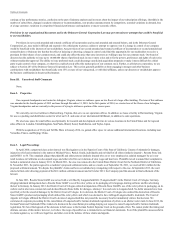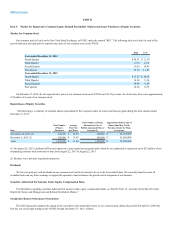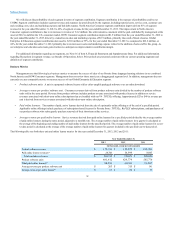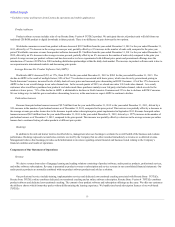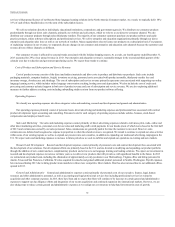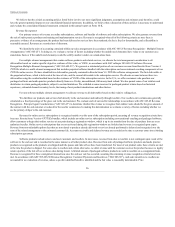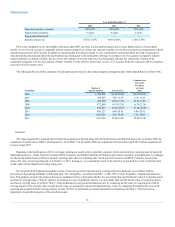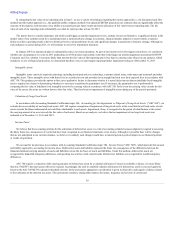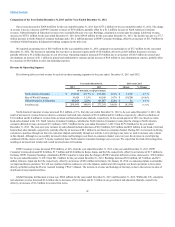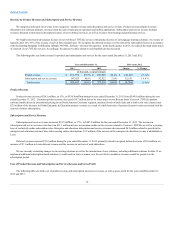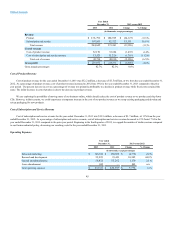Rosetta Stone 2013 Annual Report Download - page 38
Download and view the complete annual report
Please find page 38 of the 2013 Rosetta Stone annual report below. You can navigate through the pages in the report by either clicking on the pages listed below, or by using the keyword search tool below to find specific information within the annual report.
Table of Contents
Interest and other income (expense) primarily consist of interest income, interest expense, foreign exchange gains and losses, and income from litigation
settlements. Interest expense is primarily related to interest on our capital leases. Interest income represents interest received on our cash and cash equivalents.
Fluctuations in foreign currency exchange rates in our foreign subsidiaries cause foreign exchange gains and losses. Legal settlements are related to agreed upon
settlement payments from various anti-piracy enforcement efforts.
Income tax expense (benefit) consists of federal, state and foreign income taxes. For the year ended December 31, 2013, our worldwide effective tax rate
was approximately 10%. The income tax benefit in 2013 was primarily attributable to partial valuation releases related to the Livemocha and Lexia acquisitions
offset by tax expense related to current year taxable income in Canada, Germany and the U.K., foreign withholding taxes, and the tax impact of amortization of
indefinite-lived intangible assets.
We regularly evaluate the recoverability of our deferred tax assets and establish a valuation allowance, if necessary, to reduce the deferred tax assets to an
amount that is more likely than not to be realized (a likelihood of more than 50 percent). Significant judgment is required to determine whether a valuation
allowance is necessary and the amount of such valuation allowance, if appropriate.
In assessing the recoverability of our deferred tax assets, we consider all available evidence, including:
•the nature, frequency, and severity of cumulative financial reporting losses in recent years;
•the carryforward periods for the net operating loss, capital loss, and foreign tax credit carryforwards;
•predictability of future operating profitability of the character necessary to realize the asset;
•prudent and feasible tax planning strategies that would be implemented, if necessary, to protect against the loss of the deferred tax assets; and
•the effect of reversing taxable temporary differences.
The evaluation of the recoverability of the deferred tax assets requires that we weigh all positive and negative evidence to reach a conclusion that it is
more likely than not that all or some portion of the deferred tax assets will not be realized. The weight given to the evidence is commensurate with the extent to
which it can be objectively verified. The more negative evidence that exists, the more positive evidence is necessary and the more difficult it is to support a
conclusion that a valuation allowance is not needed.
As of December 31, 2012, we performed an analysis on the need for a valuation allowance on our deferred tax assets in various jurisdictions. Our
analysis considered a number of factors, including our cumulative loss over the last three years, our expectation of future taxable income and the time frame
over which our net operating losses expire. This analysis resulted in the need for valuation allowances in the U.S., Korea, Japan and Brazil. We have
maintained a valuation allowance against our deferred tax assets in the U.S., Korea, Japan and Brazil through December 31, 2013. All four jurisdictions have
cumulative losses and pre-tax losses for the most recent year ended December 31, 2013.
The establishment of a valuation allowance has no effect on the ability to use the deferred tax assets in the future to reduce cash tax payments. We will
continue to assess the likelihood that the deferred tax assets will be realizable at each reporting period, and the valuation allowance will be adjusted accordingly,
which could materially affect our financial position and results of operations.
In presenting our financial statements in conformity with accounting principles generally accepted in the U.S., we are required to make estimates and
assumptions that affect the reported amounts of assets, liabilities, revenues, costs and expenses and related disclosures.
Some of the estimates and assumptions we are required to make relate to matters that are inherently uncertain as they pertain to future events. We base
these estimates and assumptions on historical experience or on various other factors that we believe to be reasonable and appropriate under the circumstances.
On an ongoing basis, we reconsider and evaluate our estimates and assumptions. Our future estimates may change if the underlying assumptions change.
Actual results may differ significantly from these estimates.
35


